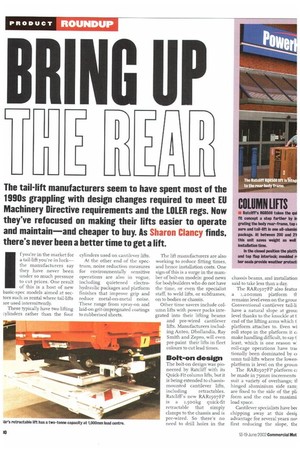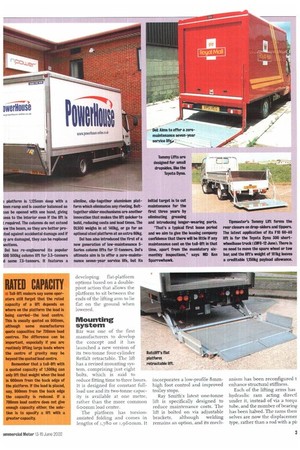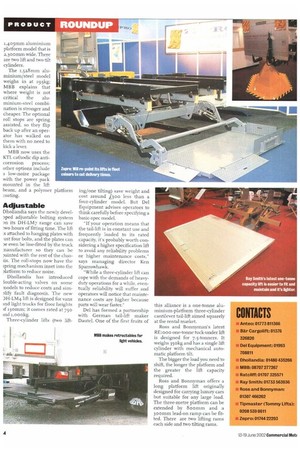The tail-lift manufacturers seem to have spent most of the
Page 30

Page 31

Page 32

Page 34

If you've noticed an error in this article please click here to report it so we can fix it.
1990s grappling with design changes required to meet EU Machinery Directive requirements and the LOLER regs. Now they've refocused on making their lifts easier to operate and maintain—and cheaper to buy. As Sharon Clancy finds, there's never been a better time to get a lift.
f you're in the market for a tail-lift you're in luck— the manufacturers say they have never been under so much pressure to cut prices. One result of this is a host of new basic-spec models aimed at sectors such as rental where tail-lifts are used intermittently.
These typically have two lifting 2ylinders rather than the four cylinders used on cantilever lifts.
At the other end of the spectrum, noise reduction measures for environmentally sensitive operations are also in vogue, including quietened electrohydraulic packages and platform finishes that improve grip and reduce metal-on-metal noise. These range from spray-on and laid-on grit-impregnated coatings to rubberised sheets. The lift manufacturers are also working to reduce fitting times, and hence installation costs. One sign of this is a surge in the number of bolt-on models: good news for bodybuilders who do not have the time, or even the specialist staff, to weld lifts, or subframes, on to bodies or chassis.
Other time savers include column lifts with power packs integrated into their lifting beams and pre-wired cantilever lifts. Manufacturers including Anteo, Dhollandia, Ray Smith and Zepro, will even pre-paint their lifts in fleet colours to cut lead times.
Bolt-on design
The bolt-on design was pioneered by Ratcliff with its Quick-Fit column lifts, but it is being extended to chassismounted cantilever lifts, including retractables. Ratcliff's new RARI5o7FP is a 1,500kg quick-fit retractable that simply clamps to the chassis and is pre-wired. So there's no need to drill holes in the chassis beams, and installation said to take less than a day.
The RARI5o7FP also featut a 1,2.00mm platform tl remains level even on the grout Conventional cantilever tail-li have a natural slope at groin level thanks to the knuckle at t end of the lifting arms which platform attaches to. Even wi roll stops in the platform it c; make handling difficult, to say least, which is one reason w. roll-cage operations have tra( tionally been dominated by a umn tail-lifts where the lower, platform is level on the groun
The RARI5o7FP platform a be made in 75mm increments suit a variety of overhangs; tl hinged aluminium side rami are fixed to the side of the ph form and the end to maximi load space.
Cantilever specialists have be chipping away at this des4 advantage for several years no, first reducing the slope, tht
developing flat-platform options based on a doublepivot action that allows the platform to sit between the ends of the lifting arm to lie flat on the ground when lowered.
Mounting system
Bar was one of the first manufacturers to develop the concept and it has launched a new version of its two-tonne four-cylinder Retfalt retractable. The lift has a revised mounting system, comprising just eight bolts, which is said to reduce fitting time to three hours. It is designed for constant fullload use and its two-tonne capacity is available at one metre, rather than the more common 6 oomm load centre.
The platform has torsionassisted folding and comes in lengths of1,78o OT 1,9 Gomm. It incorporates a low-profile 8mmhigh foot control and improved trolley stops.
Ray Smith's latest one-tonne lift is specifically designed to reduce maintenance costs. The lift is bolted on via adjustable brackets, although welding remains an option. and its mech
anism has been reconfigured t enhance structural stiffness.
Each of the lifting arms has hydraulic ram acting direct] under it, instead of via a torqu tube, and the number of bearing has been halved. The rams then selves are now the displacemer type, rather than a rod with a pit ton on the end, which improves bending resistance.
The number of hydraulic seals has been cut from six to two and there is more oil in the cylinders to improve heat dissipation. The cylinder stroke now covers deck heights ranging from six-tonne trucks to maximum-weight semitrailers.
Most one-tonne cantilever platforms are 1,200MM long, says the company, which suits the body height of most 7.5-tonne trucks. This one-tonner has a 1,400rnm platform, but Ray Smith designers have still managed to pare 5 okg off its weight. The company has also developed quietened versions of its tail-lifts, called Night Owl. The noisereduction pack comprises a sound-deadened electro-hydraulic power unit and a platform coated in a noise-reducing coating that also helps improve grip.
Night Owl
Tests of the Night Owl with hydraulic pressures ranging from 20-150 bar produced noise levels of 59.1 decibels at one metre. "That's not much more than regular urban background noise," says joint MD David Browning.
Side safety rails used to be confined to double-tier lifts where the risk of injury if operators accidentally stepped off the platform was greater, simply because of the height to which the lifts ascended. Browning reports that some operators are now requesting side rails on standard lifts to ensure they comply with employers' obligations to provide a safe working environment under the health and safety regs.
Safety rails
The company has introduced fold-down side safety rails that lie flat on the platform when out of use. The tail-lift controls will not operate until the rails have been pulled up into place, so loaders have no choice but to use them.
Anteo has developed a two-cylinder version of its deep-platform 1,5 ookg and 2,000kg tuck-under lift to improve stability when fitted to i8-tonners. The lifting arms on the 1,600mm platform are wider apart: moving to two cylinders is said to improve platform stability.
One useful idea adopted by Anteo is to attach a plate to the platform showing the rated capacity at various load centre points. It reminds drivers that the maximum lifting capacity is not available at all points and warns against overloading. Some lifts have red lines painted on them to show users their loading limits.
Anteo has also developed a fitting jig which should save bodybuilders' time, and its lifts can be finished in any colour. Retractable lifts tend to be rat at 1,500kg and above to suit ser trailers and higher-gross weiE trucks, partly because the ec weight of the sliding mechanis steals payload. But German nrz ufacturer MBB has launched KU Z retractables with 750kg a. L000kg capacities at an allweight of just I3Ikg for 1,405mm aluminium platform model that is 2,30 omm wide. There are two lift and two tilt cylinders.
The 1,52.8nim aluminium/steel model weighs in at 193kg; MBB explains that where weight is not
critical the aluminium-steel combination is stronger and cheaper. The optional roll stops are spring assisted, so they flip back up after an operator has walked on them with no need to kick a lever.
MBB now uses the KT', cathodic dip anticorrosion process; other options include a low-noise package with the power pack mounted in the lift beam, and a polymer platform
Adjustable
Dhollandia says the newly devel3ped adjustable bolting system Dn its DH-Ltv17 range can save :wo hours of fitting time. The lift .s attached to hanging plates with ust four bolts, and the plates can 3e even be line-fitted by the truck manufacturer so they can be 3ainted with the rest of the chasns. The roll-stops now have the >pring mechanism inset into the 3latform to reduce noise.
Dhollandia has introduced iouble-acting valves on some riodels to reduce costs and sim)lify fault diagnosis. The new )H-LM4 lift is designed for vans Ind light trucks for floor heights )f i3omm; it comes rated at 750 tnd L000kg.
Three-cylinder lifts (two lift
ing/one tilting) save weight and cost around L30o less than a four-cylinder model. But Del Equipment advises operators to think carefully before specifying a basic-spec model.
"If your operation means that the tail-lift is in constant use and frequently loaded to its rated capacity, it's probably worth considering a higher specification lift to avoid any reliability problems or higher maintenance costs," says managing director Ken Sparrowhawk.
"While a three-cylinder lift can cope with the demands of heavyduty operations for a while, eventually reliability will suffer and operators will notice that maintenance costs are higher because parts will wear faster."
Del has formed a partnership with German tail-lift maker Dautel. One of the first fruits of this alliance is a one-tonne aluminium-platform three-cylinder cantilever tail-lift aimed squarely at the rental market.
Ross and Bonnyman's latest REt000 one-tonne tuck-under lift is designed for 7.5-tormers. It weighs 350kg and has a single lift cylinder with mechanical automatic platform tilt.
The bigger the load you need to shift, the longer the platform and the greater the lift capacity required.
Ross and Bonnyman offers a long platform lift originally designed for carrying luxury cars but suitable for any large load. The three-metre platform can be extended by goomm and a 3oomm lead-on ramp can be fitted. There are two lifting rams each side and two tilting rams.




















































































































































